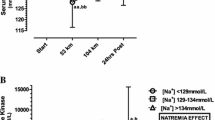Abstract
The purpose of this study was to determine if fluid-electrolyte, renal, hormonal, and cardiovascular responses during and after multi-hour water immersion were associated with aerobic training. Additionally, we compared these responses in those who trained in a hypogravic versus a 1-g environment. Seventeen men comprised three similarly aged groups: six long-distance runners, five competitive swimmers, and six untrained control subjects. Each subject underwent 5 h of immersion in water [mean (SE)] 36.0 (0.5)°C to the neck. Immediately before and at each hour of immersion, blood and urine samples were collected and analyzed for sodium (Na), potassium, osmolality, and creatinine (Cr). Plasma antidiuretic hormone and aldosterone were also measured. Hematocrits were used to calculate relative changes in plasma volume (%ΔV pl). Heart rate response to submaximal cycle ergometer exercise (35% peak oxygen uptake) was measured before and after water immersion. Water immersion induced significant increases in urine flow, Na clearance (C Na), and a 3–5% decrease in V pl. Urine flow during immersion was greater (P < 0.05) in runners [2.4 (0.4) ml · min−1] compared to controls [1.3 (0.1) ml · min −1]. However, %A V pl, C Cr, C Na and \(C_{{\text{H}}_{\text{2}} {\text{O}}}\) during immersion were not different (P > 0.05) between runners, swimmers, and controls. After 5 h of immersion, there was an increase (P < 0.05) in submaximal exercise heart rate of 9 (3) and 10 (3) beats · min−1 in both runners and controls, respectively, but no change (P > 0.05) was observed in swimmers. Since swimmers did not experience elevated exercise tachycardia following water immersion compared to runners and sedentary controls, we conclude that exercise training in a hypogravic environment attenuates the acute cardiovascular adaption to microgravity. This effect of hypogravic aerobic training was not associated with the degree of hypovolemia and associated diuresis and natriuresis.
Similar content being viewed by others
References
Boening D, Ulmer H-V, Meier U, Skipka W, Stegemann J (1972) Effects of a multi-hour immersion on trained and untrained subjects. 1. Renal function and plasma volume. Aerosp Med. 43:300–305
Claybaugh J, Pendergast D, Davis J, Akiba C, Pazik M, Hong S (1986) Fluid conservation in athletes: responses to water intake, supine posture, and immersion. J Appl Physiol 61:715
Convertino VA (1983) Heart rate and sweat rate responses associated with exercise induced hypervolemia. Med Sci Sports Exerc 15:77–82
Convertino VA (1991) Blood volume: its adaptation to endurance training. Med Sci Sports Exerc 12:1338–1348
Convertino VA, Brock PJ, Keil LC, Bernauer EM, Greenleaf JE (1980) Exercise training-induced hypervolemia: role of plasma albumin, renin, and vasopressin. J Appl Physiol 48:665–669
Convertino VA, Keil LC, Bernauer EM, Greenleaf JE (1981) Plasma volume, osmolality, vasopressin, and renin activity during graded exercise in man. J Appl Physiol 50:123–128
Convertino VA, Karst G, Kinser S, Williams D, Goldwater D (1985) Exercise capacity following simulated weightlessness in trained and nontrained subjects. Aviat Space Environ Med 56:489
Convertino VA, Mack GW, Nadel ER (1991) Elevated central venous pressure: a consequence of exercise training-induced hypervolemia? Am J Physiol 260:R273-R277
Epstein M, Pins DS, Sancho J, Haber E (1975) Suppression of plasma renin and plasma aldosterone during water immersion in normal man. J Clin Endocrinol Metab 41:618–625
Gauer H, Henry J (1963) Circulatory basis of fluid volume control. Physiol Rev 43:423–481
Greenleaf JE (1979) Plasma volume during stress in man: osmolality and red cell volume. J Appl Physiol Respir Environ Exercise Physiol 47:1031–1038
Greenleaf JE (1984) Physiological responses to prolonged bed rest and fluid immersion in humans. J Appl Physiol Respir Environ Exercise Physiol 57:619–633
Harrison M, Keil L, Wade C, Silver J, Geelen G, Greenleaf J (1986) Effect of hydration on plasma volume and endocrine responses to water immersion. J Appl Physiol 61:1410–1417
Kravik SE, Keil LC, Silver JE, Wong N, Spaul WA, Greenleaf JE (1984) Immersion diuresis without expected suppression of vasopressin. J Appl Physiol Respir Environ Exercise Physiol 57:123–128
Norsk P, Epstein M (1988) Effects of water immersion on arginine vasopressin release in humans. J Appl Physiol 64:1–10
Author information
Authors and Affiliations
Rights and permissions
About this article
Cite this article
Convertino, V.A., Tatro, D.L. & Rogan, R.B. Renal and cardiovascular responses to water immersion in trained runners and swimmers. Europ. J. Appl. Physiol. 67, 507–512 (1993). https://doi.org/10.1007/BF00241646
Accepted:
Issue Date:
DOI: https://doi.org/10.1007/BF00241646




